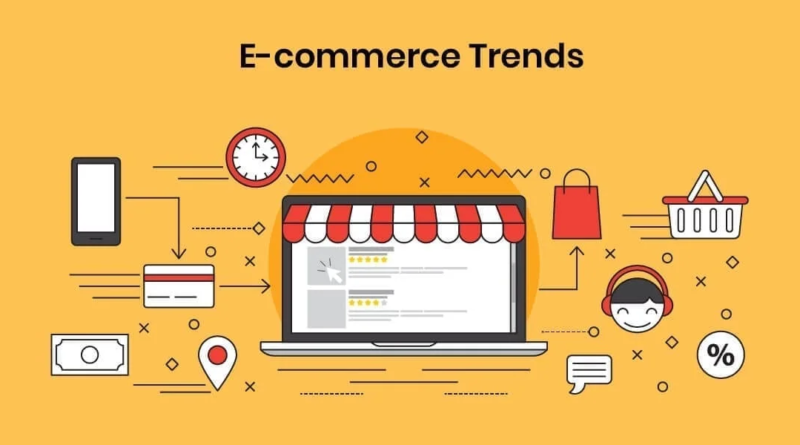Top eCommerce Trends Shaping the Online Shopping Experience
The development of eCommerce has been shifting for an extensive period of time, but the COVID-19 epidemic pushed its expansion tremendously. Following the pandemic, there was a significant increase in online sales, which drove eCommerce companies to adjust to the new reality and improve the purchasing experience for customers.
The identification of a number of important eCommerce trends that are now transforming the business was the result of detailed research of new prospects in the online commerce market.
Introduction
If you want people to become paying clients after visiting your website, you need to make sure they have a positive experience while they are there. Because your rival is easy to locate online, it is important that you supply an option that is superior to theirs.
Because of this, you should always work to improve the usability and visually appealing aspects of your eCommerce website, even if you’re using platforms like Stripe or Square .
The following article will provide you with an insight into the current trends in user experience design for e-commerce websites. We will concentrate on recent trends in the industry that might have an impact on your online business.
The following are some trends that businesses might perhaps anticipate seeing more of this year in terms of user experience design for online commerce.
Before we begin, let’s go through the fundamentals of web design.
Elements of an E-Commerce Website
- Layout refers to the process of arranging visual components, including text, infographics, images, and graphics.
- The color scheme and typefaces that make up your company’s typography, logo design, and color palette should work in harmony with your overall brand identity.
- An essential aspect of maintaining a cohesive brand image is employing a professional logo creator to ensure that your logo aligns seamlessly with your website’s design elements.
- Using a map or directory to navigate the web is related to doing the same thing in the real world.
- The copy and images should contain all relevant information.
E-commerce web design’s best techniques
E-commerce web design best practices may help you stand out in a competitive marketplace, connect with your target audience, and stay competitive as the digital world continues to develop.
User Experience Design
Create a unique and emotionally engaging experience for customers by focusing on user experience.

Use attractive visuals while ensuring easy navigation and a sophisticated search option to help customers find products effortlessly.
E-commerce brands should invest in user behavior and website analytics tools to analyze how their e-commerce website UX is performing, as well as to benchmark and a/b test improvements. With a product analytics tool, e-commerce website owners can identify areas of user friction, optimize their checkout experience, build segmented user paths, and create overall better website experiences that drive more online sales.
Brand Identity
Prioritize a brand-first design strategy to convey your business proposal value, build loyalty, and differentiate your online store from competitors.

Maintain consistency in aesthetics, messaging, fonts, and color schemes to reinforce your brand’s narrative.
Stay Updated with Trends
Adapt to evolving e-commerce trends driven by technological advancements. Incorporate interactive design, dynamic pages, and data-driven product recommendations to provide a personalized and seamless shopping experience.
Optimize for Mobile Devices
Ensure a consistent and user-friendly layout across various platforms, including PCs, smartphones, and tablets. Customers frequently switch devices, and a uniform design encourages repeat visits. Hiring a React.js developer with expertise in responsive web design can be invaluable in achieving this consistency and ensuring an optimal user experience across different devices.
In addition, you should carry out a complete seo-optimization of the site to improve its position in the search engines. Learn The Ultimate Guide to Ecommerce SEO from Serpstat and fix all the mistakes that prevent you from being first.
Customer Feedback
Establish an online community to gather feedback and utilize social proof through positive video testimonials and user-generated content. Other customers’ positive experiences on our CSAT platform validate your brand’s credibility and can positively influence potential buyers.
What Are The Top E-commerce Trends In Web Design?
These developments are influencing how e-commerce sites interact with customers, provide compelling shopping environments, and maintain a competitive edge in the fast-paced digital economy.
Augmented Reality
Augmented Reality (AR) is rapidly becoming the cornerstone of the digital retail experience.
With the use of augmented reality (AR), consumers can virtually “try on” clothing or “place” furniture in their homes before making a final purchase decision.
Virtual dressing rooms and product configurators are gaining traction, allowing consumers to see how items will fit into their lives.
This technology is set to explode in popularity, as 40% of consumers are willing to pay extra for customized products through AR solutions.
Artificial Intelligence
Artificial Intelligence (AI) is shaping the future of eCommerce with various AI marketing tools. Image recognition enhances visual commerce, allowing users to classify and find products by color and style. AI in content marketing also helps with increasing the visibility of eCommerce stores.
Personalized recommendations generated through AI algorithms are transforming customer interactions, fostering engagement and loyalty.
Additionally, predictive analytics aids in refining marketing campaigns, managing inventory, and supporting supply chain operations.
Voice Search
Voice commerce, powered by AI-driven voice recognition technology, is transforming the way people shop online.
The convenience of using voice commands to search, order, and make purchases seamlessly integrates with daily life.
Integration of voice search functionalities into eCommerce websites and mobile apps is a must to cater to this growing trend.
On-Site Personalization
Generic ads and offerings no longer cut it in the modern retail landscape.
On-site personalization leverages AI-powered search and recommendation technologies to understand customer preferences and offer tailored content, resulting in a significant boost in customer retention and sales.
Big Data
The vast troves of data collected by retailers are instrumental in creating personalized experiences. By analyzing customer behavior, retailers gain insights into patterns that drive decision-making.
Big data analytics has become crucial for predicting trends, refining marketing strategies, and optimizing supply chain operations.
Omnichannel Strategy
An omnichannel strategy integrates various purchase channels into a cohesive ecosystem, enhancing customer experiences and engagement.
A consistent shopping experience across multiple touchpoints fosters customer loyalty.
Chatbots
AI-driven chatbots have revolutionized customer service by providing 24/7 assistance, automating tasks, and improving overall customer experiences.
With natural language processing, chatbots interact with online buyers in ways similar to human sales assistants.
Mobile Shopping
Smartphones and widespread internet access have fueled the growth of mobile shopping.
If you’re not planning to create a shopping app, optimizing your eCommerce website for mobile use is essential to cater to the rising number of mobile internet users. This can be achieved through adaptive design and mobile application development.
Headless and API-Driven E-commerce
Enterprise-level retailers are turning to headless commerce platforms to seamlessly distribute products across various channels.
This architecture decouples the backend from the front end, enabling unified content delivery through APIs and enhancing control over content.
Diverse Payment Methods
Offering a range of payment options gives eCommerce stores a competitive edge.
Debit and credit cards, bank transfers, mobile payments, eWallets, and even cryptocurrencies provide customers with flexibility, reducing cart abandonment rates.
Video Commerce
Video content, especially live video streams, has become a pivotal tool for engaging online shoppers.
Product demonstrations and benefits explained through videos significantly boost sales, customer engagement and conversion rates, making it an essential addition to eCommerce websites.
Subscriptions
The subscription-based eCommerce model is gaining traction as consumers opt for regular delivery of products and services. Examples include subscription boxes, subscribe and save models, streaming services, and more.
Subscriptions help businesses easily predict sales and manage inventory because of their reliability and consistency.
Enhanced Order Fulfillment
Efficient order distribution and fulfillment processes are essential for customer satisfaction.
Distributed order management systems allocate orders to the right fulfillment centers, ensuring timely deliveries and reducing errors.
Simplified Online Purchases
Seamless online purchasing experiences are vital for customer retention.
Ensuring that customers can buy products or services across all digital channels where a brand is present enhances convenience and satisfaction. In addition, you should consider translating your eCommerce if you want to reach multilingual audience.
New Distribution Channels
Exploring new marketplaces and distribution channels expands retailers’ customer base. Entering popular marketplaces like Amazon or eBay enables retailers to tap into wider audiences.
Website Optimization
Optimizing websites for user experience is an ongoing process. Regular experimentation with design elements, layout, and loading speed ensures that customers have a smooth and enjoyable shopping journey.
Moreover, with several accessible cloud-based e-commerce platforms like CS-Cart Multi-Vendor No-Code, Shopify, WooCommerce, and Magento, more merchants can quickly and easily build their websites.
Online Advertising
As online shopping grows, so does online advertising. Retailers need to budget strategically for advertising campaigns to remain competitive in the increasingly crowded digital advertising space.
Social Commerce and Influencer Marketing
The fusion of e-commerce and social media platforms has created the realm of social commerce.
Paid advertisements, direct sales, appealing brand content, and influencer marketing on platforms like Instagram, Facebook, and TikTok can significantly boost sales and engagement rate.
Automated B2B Transactions
The B2B sector is embracing digital transformation through automation. Implementing advanced software systems streamlines transactions between companies, enhancing efficiency and competitiveness.
Data Privacy Compliance
With the collection and processing of personal data, retailers must prioritize data privacy compliance. Adhering to local data privacy laws ensures the protection of customer information and trust.
How do you choose the best 2023 website e-commerce design?
- The first thing you need to do before starting to develop an e-commerce website is to define your goals.
- Pick a layout that focuses on the essentials to create a structure that is simple for site visitors to navigate and understand.
- A flexible design makes sure that your website looks great on any device so clients can shop while they are on the go.
- Check that your website displays and functions properly across a variety of platforms, browsers, and devices before you launch it.
- Use e-commerce tools to make the checkout process more accessible, keep track of your goods, and more.
- Choose a secure e-commerce design with SSL, strong payment gateways, regular updates, and robust authentication to protect customer data and transactions.
- Because you can simply drag and drop components and blocks, you won’t need any knowledge of coding in order to construct custom pages for your online shop.
Wrapping It Up
The dynamic nature of eCommerce demands continuous adaptation to stay competitive. While trends may evolve, a customer-centric approach remains paramount. By aligning their strategies with the latest eCommerce trends, businesses can provide seamless experiences, engage customers effectively, and thrive in the ever-changing online retail landscape.
FAQs
Why is UI different from UX?
The user interface (UI) is everything that a website visitor sees. Put another way, this is a picture from a webpage.
The impression someone gets after engaging with your website is known as the “user experience,” or UX for short. Factors that fall under this category include how someone puts the offered capacity to use, how easily they can do so, what kinds of barriers they encounter, etc.
Why is User Experience Design so Important in E-commerce?
Because a pleasant user experience is the key to building trust with customers and keeping them coming back, the purpose of this device is to attract and persuade potential buyers to make a purchase. Finding out what your users want is the first step in making them happy.
It improves E-commerce conversion rate, boosts customer retention and loyalty, and creates a solid bond between you and your clientele.
When you’re thousands of miles away, and there’s no human presence on the website, you can make up for the distance and absence of emotions via UX design.

Author bio: Divyesh Bhatasana is a Founder & CEO of Jeenam Infotech LLP who has a passion for helping customers as a Link Building Consultant. You can connect with him on Linkedin.
